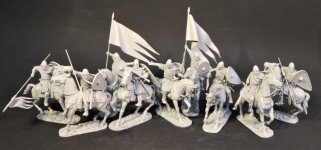Many thanks to Clive and Sue of Grey Goose Collectibles for their hard work in promoting jjD products.
PREVIEWEDAT THIS YEARS LONDON TOY SOLDIER SHOW WERE 9 NEW NORMAN KNIGHTS, for the Age Of Arthur Series.

Thesefigures are specifically designed to represent William The Conquerors army atthe Battle of Hastings 1066, and will be the perfect opponents to displayopposite the Saxon shield wall.
William Duke of Normandy (c. 1028-1087) ,who isusually known as William the Conqueror was the first Norman King of England,reigning from 1066 until his death in 1087.
In the 1050’s and early 1060’s, William becamea contender for the throne of England held by the Childless Edward theConfessor, his first cousin removed.
There were other claimants. Including thepowerful English earl Harold Godwinson, whom Edward had named as King on hisdeathbed, in January 1066.
William argued that Edward had previouslypromised the throne to him, and that Harold had sworn to support his claim.
Throughout the summer of 1066, Williamassembled an army and an invasion fleet in Normandy. This force included, inaddition to troops from William’s own territories of Normandy and Maine, largenumbers of mercenaries, allies and volunteers from Brittany, Northeast Franceand Flanders.
The Battle of Hastings took place on the 14[SUP]th[/SUP]October 1066. Although the numbers on each side were about equal, William hadthe advantage of having both cavalry, infantry and many archers.
Harold had only foot soldiers, and few archers.The English formed a shield wall along a ridge, and were initially so effectivethat the invading Norman army was repeatedly thrown back with heavy casualties.
Towards the end of the day some of William’sBreton troops panicked and fled, with some of the English troops pursuing thefleeing Bretons. These English troops who had broken ranks, were themselvesattacked and destroyed by the Norman mounted knights.
Norman knights were armoured warriors thatfought on horseback, with lance , sword and shield. These were the Norman“secret weapon” as nothing like them had been seen before in England. Therewere between 1,000-2,000 Norman knights in William’s army, and it was thesetroops which proved decisive to the invading army’s victory.
Two further Norman retreats were feigned, whichonce again drew the English into pursuit and expose them to repeated attacks bythe Norman cavalry.
It appears that the decisive event was Harold’sdeath, of which there are differing versions which are told.
William of Jumieges claimed that Harold waskilled by the Duke himself.
The Bayeux tapestry shows Harold’s death by anarrow to the eye.
Thefirst of the Norman knights will be available in the early part of 2020.
PREVIEWEDAT THIS YEARS LONDON TOY SOLDIER SHOW WERE 9 NEW NORMAN KNIGHTS, for the Age Of Arthur Series.

Thesefigures are specifically designed to represent William The Conquerors army atthe Battle of Hastings 1066, and will be the perfect opponents to displayopposite the Saxon shield wall.
William Duke of Normandy (c. 1028-1087) ,who isusually known as William the Conqueror was the first Norman King of England,reigning from 1066 until his death in 1087.
In the 1050’s and early 1060’s, William becamea contender for the throne of England held by the Childless Edward theConfessor, his first cousin removed.
There were other claimants. Including thepowerful English earl Harold Godwinson, whom Edward had named as King on hisdeathbed, in January 1066.
William argued that Edward had previouslypromised the throne to him, and that Harold had sworn to support his claim.
Throughout the summer of 1066, Williamassembled an army and an invasion fleet in Normandy. This force included, inaddition to troops from William’s own territories of Normandy and Maine, largenumbers of mercenaries, allies and volunteers from Brittany, Northeast Franceand Flanders.
The Battle of Hastings took place on the 14[SUP]th[/SUP]October 1066. Although the numbers on each side were about equal, William hadthe advantage of having both cavalry, infantry and many archers.
Harold had only foot soldiers, and few archers.The English formed a shield wall along a ridge, and were initially so effectivethat the invading Norman army was repeatedly thrown back with heavy casualties.
Towards the end of the day some of William’sBreton troops panicked and fled, with some of the English troops pursuing thefleeing Bretons. These English troops who had broken ranks, were themselvesattacked and destroyed by the Norman mounted knights.
Norman knights were armoured warriors thatfought on horseback, with lance , sword and shield. These were the Norman“secret weapon” as nothing like them had been seen before in England. Therewere between 1,000-2,000 Norman knights in William’s army, and it was thesetroops which proved decisive to the invading army’s victory.
Two further Norman retreats were feigned, whichonce again drew the English into pursuit and expose them to repeated attacks bythe Norman cavalry.
It appears that the decisive event was Harold’sdeath, of which there are differing versions which are told.
William of Jumieges claimed that Harold waskilled by the Duke himself.
The Bayeux tapestry shows Harold’s death by anarrow to the eye.
Thefirst of the Norman knights will be available in the early part of 2020.

